


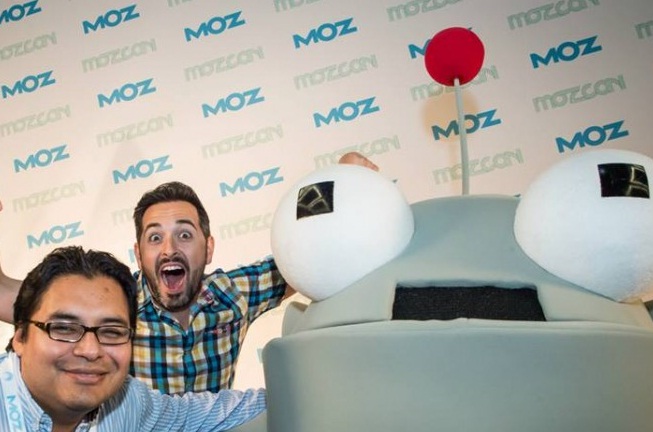
Rebranding is not a piece of cake. The process involves proper planning and execution at every stage and it carries high risks. Rebranding is though an expensive and risky exercise, if done right it can take your brand to new heights. Sometimes, rebranding becomes inevitable. It might be due to a reputation crisis or due to changing market situation or competition. Even changing customer profile or customer perception can drive brands to opt for rebranding. But when you go for rebranding you should be clear about your objectives and strategy. People often get emotionally attached to a brand, so you need to make sure that the changes carried out are sensitive to your target audience. Clear communication is the key.
As discussed, rebranding is highly risky; the level of risk also depends on the type of rebranding you want to go for. For ex: radical rebranding involves more risk than gradual rebranding. History tells us that despite proper planning and execution rebranding might go terribly wrong, but still there are great examples of companies that pulled it off. Brands like Starbucks, Microsoft, Apple, Cadbury, and Lego are classic examples of successful rebranding. On the other hand, rebranding attempts of some brands have gone awfully wrong, few of them include GAP, Tropicana, Sun Chips, MasterCard, Pizza Hut etc.
The basics of online rebranding (Here, by online rebranding we mean rebranding of online brands – a website, a product or service exclusively offered online) are not much different from offline rebranding. But yes, online rebranding comes with its own challenges.
Some of them are discussed below:
• Renaming a website’s name can cause a lot of confusion; has the ownership of the website changed? Can I expect the same service, experience or product offered in the past? What happened to my account or data? These are some of the questions that are likely to be raised.
• Users may not find the improved settings, advanced features or changed interface user-friendly or the fact that initial efforts that need to be taken to understand the changes implemented may put them off and fuel negative criticisms. You’ll have to walk the extra mile to make your users/visitors understand the benefits and encourage them to adapt accordingly.
• Rebranding may also decrease the amount of traffic to your site – visitors may lose interest due to failure to meet their expectations.
• It may also change people’s perceptions and expectations.
• If you are a brand loved by our target audience, the rebranding efforts may backfire as your audience may not like your new name, logo or appearance of the website etc. Remember, people get emotionally attached to the brands that they love.
Effective communication is the key to address the above challenges.
• Redesigning your website as a part of rebranding exercise may drastically affect your conversion rate. Engaging your audience in the redesigning process by asking for their opinions or going for a multivariate testing may help.
• Ranking positions of your pages in search engines will definitely change as you switch to a new domain, even when you opt for a 301 redirection. This may lead to significant loss of organic traffic. You need to be prepared for it.
• In case of change of domain, you also need to make sure that referral traffic may not get diverted or get lost. Visitors coming to your website through the links on various referral sites should be redirected to the right pages of your new website.
These are some of the online rebranding challenges you might face apart from the ones that are common to any type of rebranding process.
One of the classic examples of online rebranding failures was Overstock.com that introduced its new name o.co and started to create awareness about it through its web presence and also using advertising media. A lot of people got confused and typed ‘o.com’ which led them to a blank page. It faced major backlash.
Its rebranding exercise resulted in waste of money, time and energy and didn’t yield any positive results. To stop any further damage, it has started using both the names (overstock.com and o.co) in its advertising.
Though there are challenges and risks associated with online rebranding, if done right it can take your brand to new heights.
For example, the famous xing.com, the professional social networking platform, used to be known as OpenBC until 17 November 2006. OpenBC, based in Germany, was launched in 2003 and was majorly popular in German speaking countries but also had members from Europe and Far East. The company decided to expand into new markets and rebranding was necessary. The platform needed a unique, easy to remember and appealing name. It was renamed as XING and the rebranding process was carried out successfully in 2006, thanks to the much-needed media attention it got that helped them throughout the transition. Apart from renaming, the company came up with friendlier and easier to understand interface and new features. In the same year, XING went public and became the first web 2.0 company to go public in Europe. In 2007-08 the company acquired three social networking businesses namely Econozco, Neurona, Cember that helped them increase their user base further. Today, Xing has 13 million+ users from more than 200+ countries. (Source: Wikipedia ).
Thorough planning, effective Internal and external communication backed by great media attention were key to successful rebranding of OpenBC says the founder of Xing, Lars Hinrichs.
Now let’s come to the SEOMoz case – first of all, hats off to their wonderful team that pulled it off. If you are from the Internet marketing industry, I’m sure you must be aware that SEOMoz, the famous SEO software company, rebranded itself as Moz recently. Let’s analyze the case and try to find answers to these questions. How did they make it happen? What were the factors that contributed to their success? How was the successful online rebranding process carried out by their wonderful team? What do we learn from this case study?
So, here we go. How to rebrand the SEOMoz way?
• Planning
As obvious as it sounds, planning is an important part of any rebranding process. Take as much time as you can but once rebranding is launched there should not be any flip flops as they would make things worse.
According to Rand Fishkin, the transformation process started almost two years back. “For the last two years, the 130+ Mozzers across product, engineering, marketing, and operations have been working to transform this company to the next stage of our evolution” says Rand Fishkin, CEO of SEOMoz, I mean Moz 😉 . More than a year was spent to plan out the rebranding process alone says Ruth Burr, the Inbound Marketing lead at Moz.
Challenging the best practices that suggest against parallel changes, the SEOMoz team plotted a massive re-branding process that included site redesign, content overhaul, domain change with TLD change over and brand name change – all at the same time, yet they pulled it off successfully. Thanks to their high performance team that was responsible for foolproof planning and flawless execution.
So, create a foolproof plan that would include resource allocation, assigning roles and responsibilities, building team spirit and achieving coordination, technical aspects of domain change over and website revamp, Internal and external communication and also the post-launch do’s and don’ts.
• Brand Name and Roger Mozbot

As discussed before changing a brand name is highly risky. Choosing a name that would match your brand’s image and also be admired by our audience is quite a challenge. The name should also be easy to remember and appealing so that your potential customers may like it. For ex: Choosing a more attractive name like Xing worked for Xing.com. The name appealed to the global audience and the same wouldn’t have probably been possible with a name like ‘OpenBC’.
SEOMoz did a great job by retaining a part of their old name so that they don’t lose the brand identity though dropping ‘SEO’ from the name was necessary as they expanded their product portfolio which also included non-SEO products and they were changing from being known as a ‘ SEO software company’ to ‘marketing software company’. Moreover ‘Moz’ sounds simpler than SEOMoz. Isn’t it?
Another smart move made by the team was to retain the Roger Mozbot, SEO Moz’s mascot. Well, just like logos, mascots too become integral part of branding. What comes to your mind when you think about McDonald’s as a brand? Apart from logo, I’m sure most of them would say ‘Ronald McDonald’, the primary mascot of McDonald’s that has become an integral part of their brand identity.
In case of SEOMoz, I believe the mascot enjoyed more recognition than their logo. Though changing the logo was inevitable, they thoughtfully retained the mascot. After all, who doesn’t love Mr.Moz, the mascot that has become an inseparable identity of Mozzers?
Here are a few lovely pictures of Roger Mozbot:
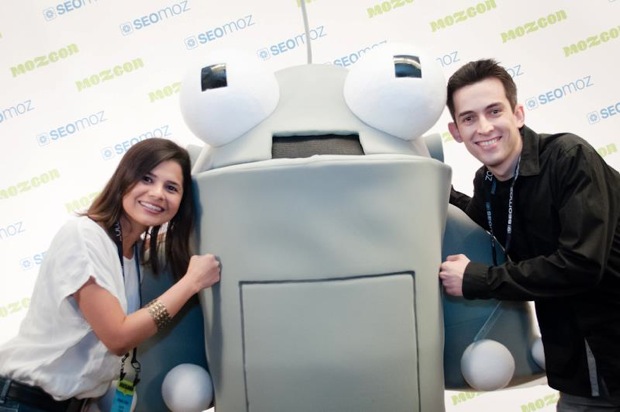
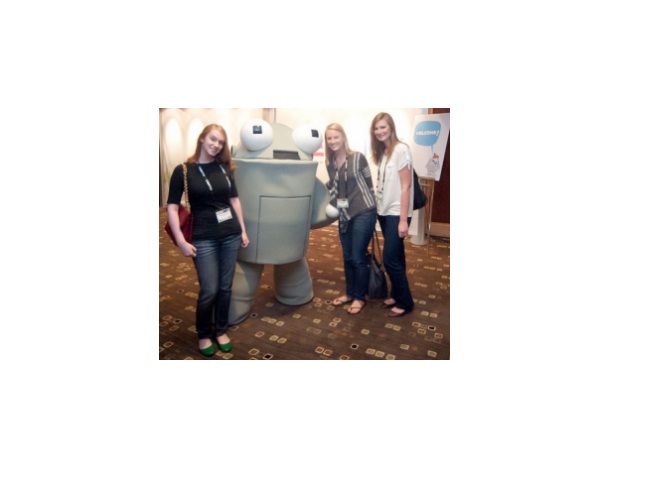

Rand Fishkin, CEO of Moz, in a playful mood. If you want to have a chat with Roger Mozbot, you can join him on Twitter
When it comes to rebranding, either logo, mascot or anything that makes people recognize or identify your brand, should be changed or redesigned only after careful consideration.
Retaining the logo or mascot in a way retains trust in the brand in spite of major changes that happen around during a rebranding process. It makes one believe that it’s the same company that’s changing for the better.
It doesn’t mean that logo or mascot should not be changed or redesigned. You should take the value of the brand elements into account. Changing a well-recognized and popular brand element should be avoided unless it’s absolutely necessary. For ex: the current logo doesn’t convey your rebranding message and may create confusion.
• Communication and PR
Effective communication is the key to successful rebranding. It’s more about convincing your loyal customer base and also to create as much as awareness about the change than just launching the rebrand with an announcement and a press release. You need to create as much excitement and buzz that any negative criticisms that may arise should get overshadowed or suppressed. Your loyal customers should feel excited and happy about the rebranding and believe firmly that the company is changing for the better.
At SEOMoz, rebranding was nothing short of a festival. The Mozzers not only celebrated it but also involved their loyal audience in the celebration. They not only reached out to the influencers but also activated their fans to spread the word, thanks to their great network and the reputation they enjoy in the industry. If you have a network of great people who can turn into brand ambassadors whenever you need them to, you can bet big on rebranding.
Pre-launch Activities: SEOMoz started the rebranding campaign much before the announcement about it was made. Rand Fishkin started tweeting about the big surprise that was about to come. His count down tweets created so much excitement and people did expect that something big was going to happen. These types of pre-launch activities or heads ups will not only increase expectations and in turn create awareness but will also help mitigate the displeasing instant reactions that may come from the customers in response to your rebranding launch. They also encouraged people to sign up to make it to the list of people who would first get to know about the #newmoz .
Bringing uninformed, unexpected changes is always risky; one fine day, telling your customers that the logo or brand name they have always loved has been changed as a part of the rebranding process may trigger instant displeasing reactions from them.
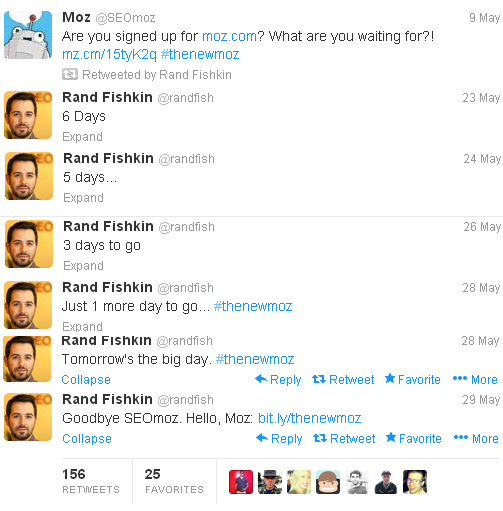
Leadership: After all the buzz created through the pre-launch activities, on the big day Rand Fishkin came up with an amazing post where he announced the news about rebranding. In the post he shared various things including the reasons for rebranding, the vision and mission of the company, the launch of Moz Analytics, Future plans, other changes and announcements.
Should CEO be the public face of the company? The answer is a BIG yes. It helps the company in a lot of ways when its CEO successfully connects with the customers, interacts with them, engages them, entertains them and eventually becomes an admirable figure. Today’s CEOs have better options to connect with their target audience effectively, thanks to social media. But it’s a surprising fact that 70% of Fortune 500 CEOs aren’t still using social media (I wrote a post on a similar topic titled ‘Social Media the Richard Branson Way’ a couple of months back. You can read the post here )
What happened when an admirable person like Rand Fishkin, a thought leader who enjoys great respect in the industry came up with a post to announce his company’s rebranding launch?
Well, they received tremendous response from the International Internet marketing community. Encouraging and welcoming comments followed.
Here are the stats (so far):
• Comments for the post – 415
• Tweets – 2118
• Facebook Likes – 1200+
• Google+ – 1600+
These are the social sharing stats of only the post. Think about the level of awareness they must have created by getting the posts shared by influencers and loyal customers. Think about the level of awareness they must have created by sharing this post on their social channels where they have thousands of followers and fans and the viral effect that it would have generated.
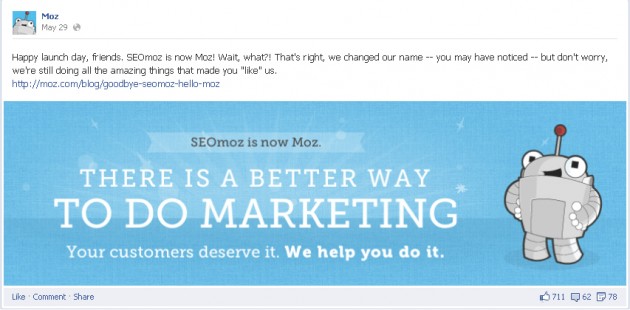
Customer Engagement: The best thing about the communication part was that they involved the customers and the loyal Moz community. They transparently shared their company’s vision and mission, future plans and products to be launched and more. The cheerful Mozzers left no stone unturned when it came to responding to the users’ comments and queries.
The takeaways here are; involve your loyal customers in the rebranding process, let them become part of the process. Making them feel that they are part of the family makes a big difference. It creates a sense of belongingness. Secondly, rebranding process might create a lot of confusions and expectations, promptly respond to comments and queries. Be proactive.
When you engage your loyal customers and make them feel like a part of the changing process, they become unpaid brand ambassadors. Activate your fans! You know the power of word of mouth marketing right? I’m sure the SEOMoz rebranding story was discussed by people all over the web, thanks to their loyal fans, influencers and of course the Media.
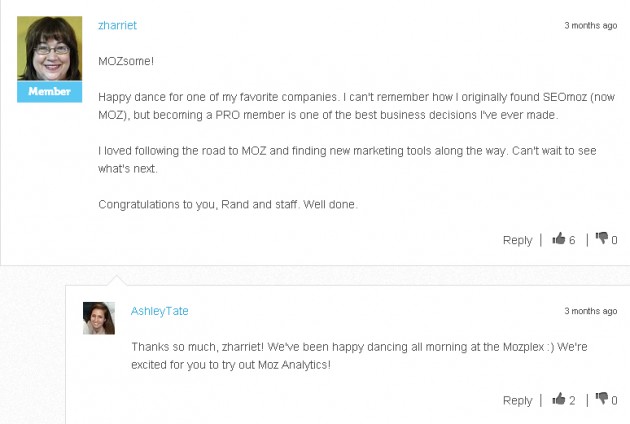
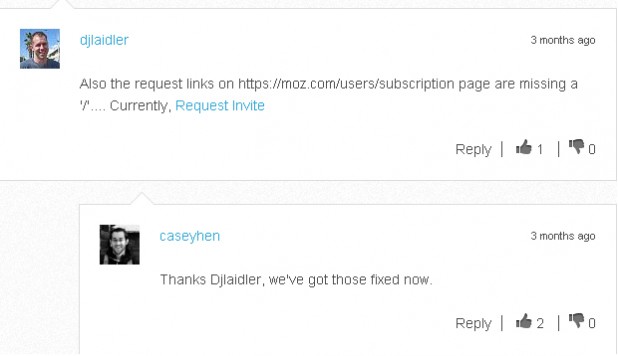
Soon after the launch and celebrations, Media too joined the party. The rebranding news got published on various reputable media, industry news and resource sites like marketingpilgrim.com, forbes.com, searchenginejournal.com, webpronews.com, marketingland.com, thenextweb.com, blog.seattletimes.com and various other local and international news sites and blogs.
Having strong media contacts and influence is an added advantage. Ensuring good press coverage of your rebranding launch enables you to create great awareness about it.
So much awareness and excitement about the launch were created that even Google says SEOMoz is now Moz 😉
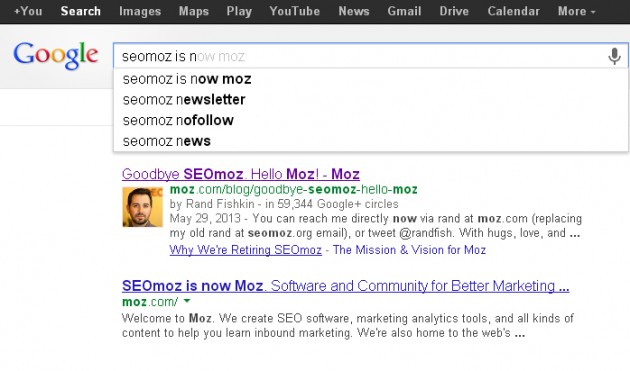
• Technical
This is the major challenge when it comes to online rebranding. When you switch your domain, lot of issues tend to arise. When you set redirection from the old domain to new one, the ranking positions of your indexed pages are likely to change drastically and loss of significant traffic is certain.
SEOMoz team faced a complex challenge. They had to change the domain and also TLDs from .org to .com. The entire URL structure and architecture information were going to be changed. They were also going to remove a bunch of old stuff and add a bunch of new stuff. Moreover the site had to be redesigned. They had thousands of pages that were tweeted, liked and +1ed by thousands of people. Preserving social share data during domain migration was also one of the objectives.
What they were going to do was much against the best practices that suggest against parallel changes. But still they made it happen, thanks to their highly competent team of engineers and SEOs. Credit goes to Ruth Burr, the inbound marketing lead at Moz, who accepted the challenge and led the team to success.
So, how much organic traffic did they lose after the domain migration? They lost 20% organic traffic within a month, which was not bad. They actually minimized the loss of traffic. The SEO team’s technical expertise made all the difference. There are cases where sites have lost more than 50-70% of the organic traffic.
Though they lost 20% of organic traffic, the loss was compensated by the rise in direct and referral traffic.
The take away here is that when you decide to switch domain, make sure you have a highly competent technical team and also weigh the pros and cons before taking the big leap. Most importantly, check the history of the new domain that you want to migrate to.
To know more about migration process carried out by Moz team, read Ruth Burr’s article, Domain Migrations – Surviving the “Perfect Storm” of site changes or you can listen to her webinar here . But webinar is available for members only. You can sign up, it’s free. You can also download the PPTs of the same webinar free of cost.
Results:
The Screenshots below show the amount of traffic flow during the two months before domain migration and two months after the migration.
Overall Traffic:

More than 20% increase in overall traffic.
Organic Traffic:

Less than 20% loss of organic traffic
Direct Traffic:

Direct Traffic almost increased by 50%
Referral Traffic:

Referral Traffic increased by slightly more than 1%.
Source (Traffic Data): 10 Traffic Graphs from the SEOMoz to Moz Domain Migration
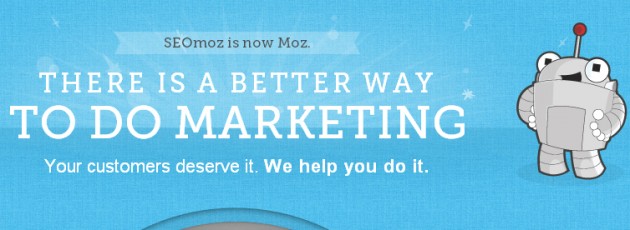
I dedicate this article to Rand Fishkin, Ruth Burr and the whole Moz team for carrying out a successful online rebranding process. I hope the SEOMoz case study will be referred, discussed, studied whenever there is a talk about online rebranding in the future.
Do let us know your views in the comment section below.
Image Courtesy: Moz.com
Connect with us on Facebook
 7 Workable Digital Marketing Ideas to Grow your Manufacturing SMB
7 Workable Digital Marketing Ideas to Grow your Manufacturing SMB
 10 ways to get your creative juices flowing
10 ways to get your creative juices flowing
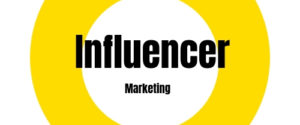 How Marketers Can Overcome These Influencer Marketing Challenges
How Marketers Can Overcome These Influencer Marketing Challenges